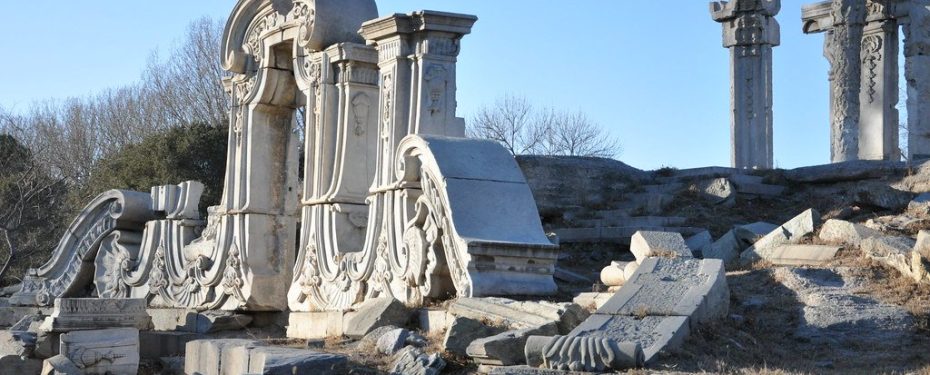Yuanmingyuan: China’s Lost Imperial Paradise
Beijing hides a treasure most tourists miss: Yuanmingyuan (圆明园). Once China’s most splendid palace, it now stands in ruins—a silent witness to history’s twists.
Bigger than the Forbidden City and blending East-West styles, it was the pride of emperors. But in 1860, war turned this paradise to ashes. Today, it’s not just old stones; it’s a place that stirs the soul. Come explore Yuanmingyuan’s untold story—where beauty, loss, and resilience intertwine in every crumbling arch.
Table of Contents
Discover Yuanmingyuan (圆明园): Beijing’s Hidden Gem
Ever heard of Yuanmingyuan (圆明园)? Many people overlook a hidden treasure in Beijing that waits to be discovered. Most people visit the Forbidden City, but Yuanmingyuan offers a special look at China’s past.

A Huge Palace Complex
Yuanmingyuan, also called the Old Summer Palace, was once a massive palace complex. It was the pride of the Qing Dynasty. Covering 350 hectares, it was five times bigger than the Forbidden City!
Built by Two Famous Emperors
Two great emperors made Yuanmingyuan their home. The Kangxi Emperor started building it in 1707. Later, his grandson, the Qianlong Emperor, made it even grander. Under them, it showed how strong China was.
East Meets West
What made Yuanmingyuan special? It mixed styles! It had classic Chinese gardens, but also something surprising: Western Mansions. These European-style buildings showed the Qing Dynasty was open to new ideas.

The Artist Who Mixed Styles
Giuseppe Castiglione, an Italian artist, blended these styles. He used Chinese beauty with European methods. His work made Yuanmingyuan a symbol of 18th-century global sharing.
Scenic Spots That Inspired Kings
All over the palace grounds, there were beautiful scenic spots. From quiet lakes to green gardens, each place was special.
One famous area had 40 different scenes! Some spots showed mountain views, while others had cozy tea houses. These scenic spots weren’t just pretty—they inspired the emperors to write poems, paint, and think deeply.
A Sad Fall: China’s Deep Hurt
Sadly, Yuanmingyuan’s glory didn’t last. In 1860, during the Second Opium War, tragedy struck. French and British troops, working together, attacked Beijing. Their target? The beautiful Yuanmingyuan.
A Leader’s Harsh Choice
Lord Elgin, leading the British, made a tough call. He ordered his men to rob and burn the palace. He did this to punish the Qing rulers. The results were heartbreaking.
Three Days of Fire
For three days, French and British forces went wild. The French allied forces joined in, making the damage worse. They set fires, stole treasures, and wrecked centuries of culture. The palace, built over generations, was ruined in just 72 hours.

What remains today
Now, Yuanmingyuan stands as a reminder of that sad event. Its broken parts and empty spaces tell a heavy story. But some treasures survived, giving hope.
Animal Heads Come Home
The bronze animal heads are famous survivors. These zodiac sculptures once decorated a water clock fountain. Stolen during the attack, many have come back to China. This return shows slow healing.
Palace Grounds: A Walk Through Time
Today, walking the palace grounds is like stepping back in time. Though in ruins, the layout is still clear. You can follow old paths where emperors once walked. Maps and signs help you picture the lost buildings.
Nature Reclaims Its Space
In a touching way, nature is healing Yuanmingyuan’s scars. Wild flowers grow around fallen columns.
Birds nest in old walls. The palace grounds, once carefully planned, now blend with natural beauty. This mix of ruins and regrowth creates a peaceful, thoughtful mood.

Why Visit Yuanmingyuan Now?
You might think, “Why see ruins?” Because it offers a deep experience. It’s not just old stones; it’s a place to reflect, learn, and connect.
Learn History by Being There
Walking through Yuanmingyuan, you’ll really feel the impact of the Opium Wars. It shows how conflicts can destroy culture. This lesson matters in today’s connected world.
Picture Its Past Glory
Even now, you can see hints of its old beauty. Foundation layouts show how big the lost buildings were. Signs describe vanished halls and gardens. Use your imagination to see its past splendor.
Great for Photos
Love taking pictures? Yuanmingyuan is perfect. Light and shadow on the ruins make great photos. Morning mist or sunset light adds a magical feel.

Plan Your Trip
Yuanmingyuan is easy to reach in Beijing’s Haidian area. Here’s how to make your visit great:
- Go Early: Beat crowds and get soft morning light.
- Take Your Time: Allow 3-4 hours to see it all.
- Wear Good Shoes: It’s big, so be comfy.
- Use a Guide App: Many bring ruins to life with tech.
- Visit the Museum: See saved items and learn more.
Seasonal Beauty on the Palace Grounds
Yuanmingyuan’s charm changes with the seasons:
- Spring: Cherry blossoms dot the ruins in pink.
- Summer: Lotus flowers fill old ponds.
- Fall: Golden leaves cover the pathways.
- Winter: Snow on broken arches looks magical.
Each season adds its own beauty to the palace grounds. This shows that even in ruin, Yuanmingyuan keeps changing and staying alive.
More Than a Sight: Yuanmingyuan’s Message
Visiting Yuanmingyuan is not just sightseeing. It’s an emotional trip through China’s highs and lows. This place shows strength—a nation’s power to remember, learn, and grow.
In our fast world, places like this are rare. They ask us to slow down, think about history’s lessons, and value culture. When you’re in Beijing, go off the main path. Find Yuanmingyuan, where every stone tells a tale of greatness, loss, and the spirit that never dies.
Call: (+86) 135 7702 4672 | Email: sales@travelchinawith.me
© Copyright 2012 - 2024, TravelChinaWith.Me | Hosting by ChemiCloud





